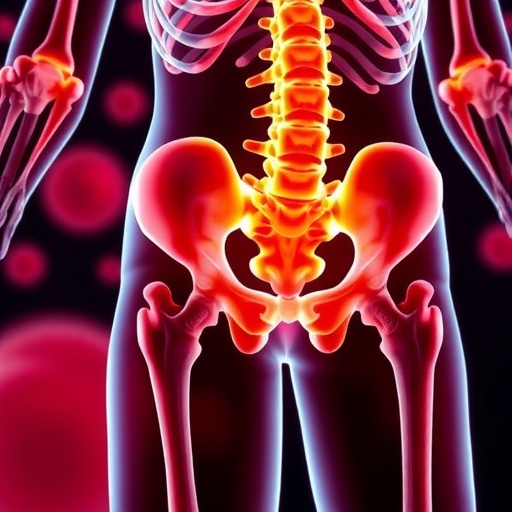In a groundbreaking study set to reshape our understanding of osteoporosis, researchers have uncovered the complex genetic underpinnings of bone marrow fat fraction and its direct involvement in osteoporosis risk. The research, led by Zhen Wu, Yong Yang, Cheng Ning, and colleagues, represents a monumental leap in unraveling the mysteries behind bone health and fragility, providing unprecedented insights into the biological interplay between marrow adiposity and bone strength. Published in Nature Communications, this study leverages cutting-edge genetic analysis techniques to map the intricate architecture dictating fat accumulation in bone marrow and its consequential influence on skeletal integrity.
Osteoporosis, a condition characterized by decreased bone density and increased fracture susceptibility, affects millions worldwide, posing a significant public health challenge. Until recently, the role of bone marrow fat—a type of adipose tissue residing within the medullary cavity—in this disease remained a topic of debate. The study by Wu et al. decisively bridges this knowledge gap by illuminating how genetic variations associated with marrow fat fraction correlate with osteoporosis risk factors, ultimately linking adiposity within the marrow to compromised bone quality.
Using a large-scale genome-wide association study (GWAS), the researchers analyzed genetic data from tens of thousands of individuals, identifying numerous loci that influence bone marrow fat content. Their approach transcended traditional imaging and biochemical assessments by incorporating advanced bioinformatics to parse the subtle yet impactful genetic determinants of marrow fat fraction. This comprehensive genetic mapping enabled the team to pinpoint specific gene clusters and pathways that orchestrate fat accumulation in bone marrow, unraveling a previously obscured biological nexus influencing bone health.
.adsslot_nehRfdEAqH{ width:728px !important; height:90px !important; }
@media (max-width:1199px) { .adsslot_nehRfdEAqH{ width:468px !important; height:60px !important; } }
@media (max-width:767px) { .adsslot_nehRfdEAqH{ width:320px !important; height:50px !important; } }
ADVERTISEMENT
What distinguishes this study is the detailed integration of phenotypic and genotypic data. Utilizing magnetic resonance imaging (MRI) to quantify bone marrow fat fraction, the researchers coupled these phenotypic measurements with genetic information to explore cause-and-effect relationships. Sophisticated statistical modeling revealed that higher marrow fat fraction, driven by certain genetic variants, corresponded with decreased bone mineral density (BMD) and increased osteoporosis susceptibility—solidifying marrow adiposity as a pivotal mediator in bone fragility syndromes.
Beyond mere association, the team ventured into functional analyses to understand the mechanisms through which marrow fat impacts bone remodeling. They observed that elevated marrow adiposity disrupts the delicate balance between osteoblasts (bone-forming cells) and osteoclasts (bone-resorbing cells), skewing the microenvironment towards bone loss. This discovery sheds light on how marrow fat may exert paracrine effects, secreting adipokines and cytokines that impair osteogenesis and promote bone resorption, thereby exacerbating osteoporotic progression.
The study also highlights the pleiotropic nature of certain genetic loci, revealing overlapping influences on bone marrow fat, overall adiposity, and metabolic health. Intriguingly, some variants implicated in marrow fat fraction are linked with broader metabolic conditions, hinting at a systemic axis connecting skeletal and metabolic homeostasis. This cross-talk between fat metabolism and bone biology opens novel avenues for therapeutic intervention, where targeting marrow fat might concurrently benefit bone health and metabolic syndrome components.
Emerging from this research is the recognition of bone marrow fat fraction as a heritable and modifiable phenotype. Unlike many static risk factors, marrow adiposity demonstrates dynamic plasticity, responsive to environmental factors such as diet, physical activity, and pharmacological agents. The genetic blueprint uncovered by Wu et al. equips clinicians and researchers with predictive markers to identify individuals at heightened risk and tailor preventive strategies aimed at modulating marrow fat to preserve skeletal integrity.
Moreover, the implications of this study transcend osteoporosis alone. The genetic determinants of marrow fat fraction may hold relevance for other pathological states characterized by altered bone-fat balance, including bone marrow disorders, hematological malignancies, and age-related skeletal degeneration. Understanding these genetic influences in diverse contexts could revolutionize our approach to diseases where bone marrow microenvironment plays a critical role.
The comprehensive nature of this investigation was made possible by integrating multi-omic data sets, advanced imaging modalities, and robust computational frameworks. The use of polygenic risk scores derived from identified variants offers promise for clinical translation, enabling personalized medicine approaches that stratify fracture risk with greater precision than conventional diagnostic tools. This evolution towards genomically informed bone health evaluation represents a paradigm shift in osteoporosis management.
One particularly striking aspect of the findings pertains to sex-specific genetic effects on marrow fat accumulation. The study illustrates that certain genetic variants exert differential influences in males and females, potentially explaining observed epidemiological differences in osteoporosis prevalence and fracture patterns between sexes. This nuanced understanding underscores the necessity of incorporating sex as a biological variable in future skeletal health research.
In addition, the work by Wu and colleagues underscores the pivotal role of adipocyte lineage commitment within the bone marrow niche. Genetic loci associated with marrow fat fraction converge on pathways regulating adipogenesis versus osteogenesis, reflecting a developmental crossroad where mesenchymal stem cells choose between fat and bone cell fates. This insight reveals potential molecular targets that could shift this balance therapeutically, favoring bone formation over fat accumulation to avert osteoporosis.
The study also raises critical questions about the intersection of aging, marrow adiposity, and bone loss. As aging progresses, marrow fat fraction naturally increases, correlating with diminished bone strength. The identified genetic architecture provides a framework to dissect how age-related changes in gene expression and cellular signaling contribute to marrow fat dynamics, offering prospects for interventions that maintain skeletal resilience in the elderly population.
Importantly, the research encourages revisiting current osteoporosis treatment paradigms. Most therapies focus on inhibiting bone resorption or stimulating bone formation but neglect the potential impact of marrow fat. Wu et al.’s findings suggest that targeting marrow adiposity—either through lifestyle modifications or novel pharmacologic agents—could complement existing treatments and enhance efficacy by restoring a healthier bone marrow environment.
As the global burden of osteoporosis continues to escalate, fueled by aging populations and lifestyle changes, this study injects fresh momentum into preventive and therapeutic strategies. The clear genetic links established between marrow fat fraction and osteoporosis risk herald new frontiers in precision medicine, where genomics guides interventions tailored to individual marrow microenvironments. The ripple effects of this research are poised to resonate across endocrinology, orthopedics, and metabolic medicine.
In summary, the elucidation of the genetic foundations of bone marrow fat fraction marks a seminal advance in bone biology and disease. By connecting the dots between genetics, marrow adiposity, and osteoporosis susceptibility, Wu and colleagues have opened a vital window into the multifaceted etiology of bone fragility diseases. The potential to transform diagnostic, preventive, and therapeutic landscapes in osteoporosis underscores the far-reaching impact of this landmark work, setting a vibrant course for future investigations into the skeletal system’s genetic and metabolic intricacies.
Subject of Research: Genetic architecture of bone marrow fat fraction and its role in osteoporosis risk
Article Title: Genetic architecture of bone marrow fat fraction implies its involvement in osteoporosis risk
Article References:
Wu, Z., Yang, Y., Ning, C. et al. Genetic architecture of bone marrow fat fraction implies its involvement in osteoporosis risk. Nat Commun 16, 7490 (2025). https://doi.org/10.1038/s41467-025-62826-3
Image Credits: AI Generated
Tags: biological mechanisms of osteoporosisbone density and fracture riskbone marrow fat and osteoporosisfat accumulation in bone marrowgenetic factors in bone healthgenetic variations in bone qualitygenome-wide association study in osteoporosisgroundbreaking osteoporosis research findingsmarrow adiposity and skeletal integrityosteoporosis risk assessmentpublic health implications of osteoporosisrelationship between adiposity and bone strength





